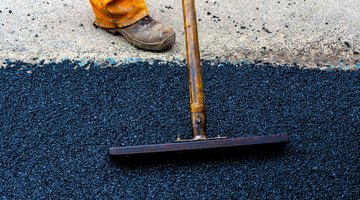Tips for Using Cold-Patch Asphalt With Cement Powder
Cold-patch asphalt uses traditional asphalt modified with polymer technology to create a product that you can use to patch your patio or driveway without the mess and danger of working with hot asphalt.

The other advantage of cold asphalt patching is that it doesn’t require a heavy roller to flatten and set it in place.
Appropriate Projects
Projects that you might use cold-patch asphalt for include filling in a depression or hole in your driveway, patio or other asphalt surface. Filling in depressions helps to prevent standing water from collecting on your driveway or patio. Small holes, sometimes called chuckholes, can present a safety hazard — they can cause people to trip. They can also be hard on your tires.
Application Methods
Many cold-patch asphalt products can be applied directly to the area you want to patch and then tamped down with the flat side of a shovel. For the best results, though, put a little extra care into the project. First, clean the area. Remove any loose debris, hose off dirt and wash away grease with a grease-cutting detergent. A clean surface gives you the best adherence between your existing surface and the patch. Next, remove any standing water. A damp surface is okay, but standing water will compromise the patch. Then paint on a layer of driveway coating. Once that’s dry, add the cold patch with a trowel until it’s level with, or a little higher than, the surface. Tamp it down with a shovel or with the end of a two-by-four. Sprinkle cement powder over the top of the patch to prevent the cold-patch material from tracking or bleeding and to help it to set faster.
Choosing the Right Conditions
You can use cold-patch asphalt in all but the most extreme conditions. It will bond with your existing surface, even in below-freezing temperatures or on very hot days. If the temperature is greater than 100 degrees, wait for a cooler day because the patch will take much longer to set in the high heat. On hot days, covering the patch with cement powder is especially helpful in getting it to set.
While the cold patch will adhere to a dry or damp surface, you’ll have better luck working on a dry day.
References
Writer Bio
Heather Robson has more than 10 years of professional writing experience with articles appearing in publications such as "Portland Magazine" and "Treasure Valley Family Magazine." Her education is in physics and English literature, so she's ready to tackle any topic that comes her way.
More Articles



